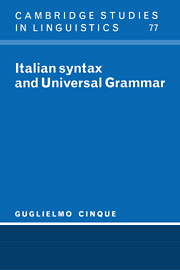Book contents
- Frontmatter
- Contents
- Introduction
- 1 On extraction from NP in Italian
- 2 On the theory of relative clauses and markedness
- 3 Bare quantifiers, quantified NPs, and the notion of operator at S-structure
- 4 On si constructions and the theory of arb
- 5 Ci si
- 6 On a difference between English and Italian “Complement Object Deletion” constructions
- 7 Ergative adjectives and the Lexicalist Hypothesis
- 8 The pseudo-relative and ACC-ing constructions after verbs of perception
- 9 On leftward movement of tutto in Italian
- 10 On the evidence for partial N-movement in the Romance DP
- References
- Index
2 - On the theory of relative clauses and markedness
Published online by Cambridge University Press: 01 October 2009
- Frontmatter
- Contents
- Introduction
- 1 On extraction from NP in Italian
- 2 On the theory of relative clauses and markedness
- 3 Bare quantifiers, quantified NPs, and the notion of operator at S-structure
- 4 On si constructions and the theory of arb
- 5 Ci si
- 6 On a difference between English and Italian “Complement Object Deletion” constructions
- 7 Ergative adjectives and the Lexicalist Hypothesis
- 8 The pseudo-relative and ACC-ing constructions after verbs of perception
- 9 On leftward movement of tutto in Italian
- 10 On the evidence for partial N-movement in the Romance DP
- References
- Index
Summary
A guiding assumption of much current work in the theory of grammar is that (most) apparent differences among languages are merely the superficial consequences of relatively few different choices open to languages at an abstract level, at the margins of a unitary core, invariant across languages. In comparing, in their essentials, the relativization systems of Italian, French, and English, we will aim at a fundamentally unified treatment of the three systems, in spite of the many overt differences existing among them. In particular, we will try to show that it is possible to assign to the three languages one and the same theoretical apparatus for relative clause constructions and to localize a number of significant differences among them in terms of the slightly different way the three languages utilize this apparatus – perhaps one or two parametric choices. The analysis is conducted more broadly within the framework of the Extended Standard Theory, specifically, within the version of it presented in Chomsky (1979a, 1981a) and recent related work.
We will begin by giving (section 1) a somewhat more detailed analysis of Italian relative constructions and will sketch, in so doing, what we take to be the “core” grammar of relative clause structures for this type of languages. The French and English systems will then be discussed (section 2) against the background of the general conclusions arrived at on the basis of Italian.
- Type
- Chapter
- Information
- Italian Syntax and Universal Grammar , pp. 54 - 103Publisher: Cambridge University PressPrint publication year: 1996



